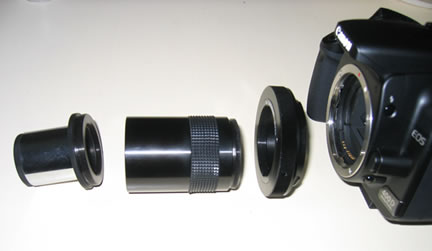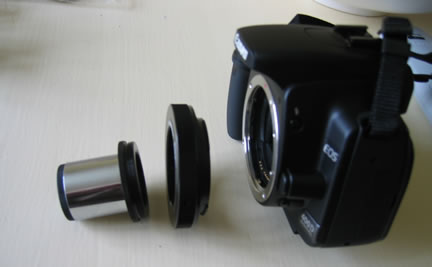Using an SLR Camera for Prime Focus Astronomy
Prime Focus is the name given when you take the lens off of the camera and insert it directly into the telescope. In order to do this you will require a number of extra astronomy adaptors.
T-Ring
The first one is the T-Ring which screws directly into the neck of the camera. Not an expensive part to purchase, mine for my Canon 400D was around £10. But they do all differ, so make sure you get the correct make and model to match your camera.
Check out Pixmania who stock T-Ring adaptors for Nikon and Canon SLR Cameras.
1.25″ Camera Adaptor
This optional adaptor is used for prime-focus and eyepiece-projection astrophotography with SCTs and refractors. It can also be used successfully with many Newtonian telescopes that either have removable sections on the eyepiece holder (to allow the camera to reach focus), or by employing a 2x Barlow lens to extend the focus point.
The rear section screws onto the nosepiece and is designed to hold a 1.25” eyepiece (ideally a mid-focal length Plossl, say a 12.5 to 20mm) for eyepiece-projection photography, with a thumb screw to lock the eyepiece in position, or you can just leave this part on without an eyepeice inserted.
The 1.25″ adaptor comes with the nosepiece and cost me around £15.
The image below shows how the pieces fit together, with the camera, then T-ring, the 1.25″ camera adaptor and then the nosepiece adaptor.
Nosepiece Adaptor
This adaptor can either be used together with the 1.2″ Camera Adaptor above (and it usually comes with the above adaptor anyway) or on it’s own with the T-Ring.
This nosepiece adaptor allows any digital or film interchangeable lens SLR (single lens reflex) camera to be attached to any 1.25” eyepiece holder. So you just slot this part into the telescope.
The front nosepiece section – which is usually threaded can also take standard filters. Using the nosepiece alone allows simple prime-focus photography and you can also use it with a Barlow lens to increase the image scale.
You can purchase a nosepiece separately (the chrome part) and it will cost about £6.
The image below shows the SLR camera then the T-Ring and the nosepiece, I also have a moon filter at the front of the nosepiece:
So all in all the cost of adapting your camera for telescope photography is not expensive at all and really easy to setup, it’s just the cost of a good SLR digital camera in the first place is the expensive bit.


